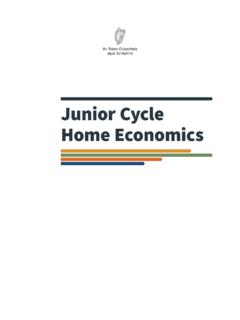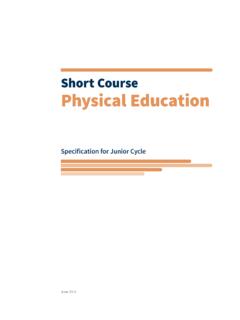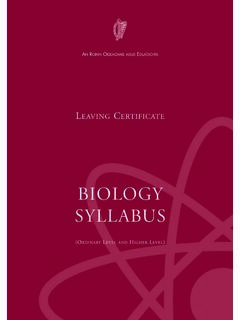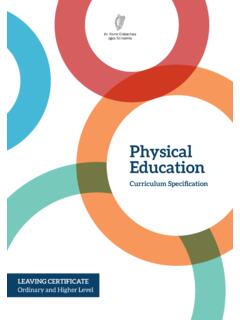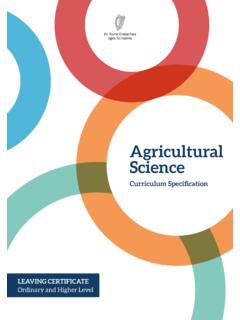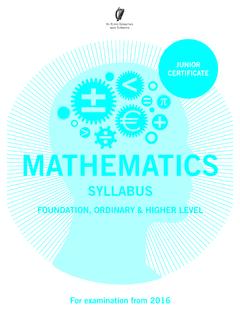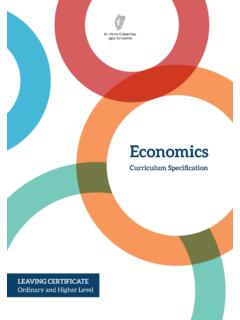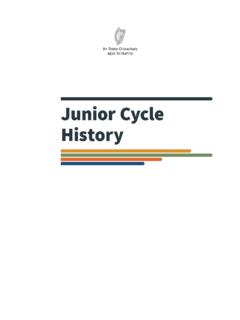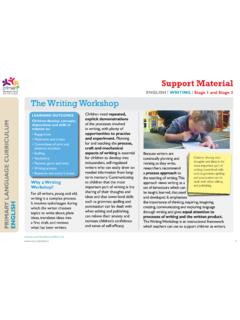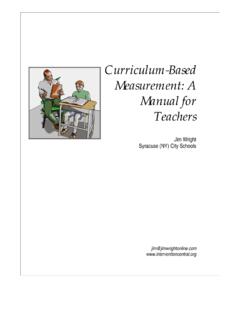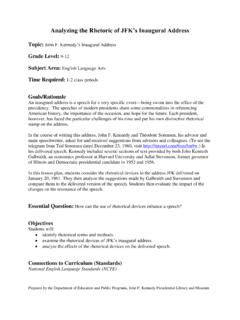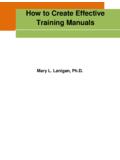Transcription of Mathematics - Curriculum
1 MathematicsTeacher GuidelinesPrimary SchoolCurriculumDUBLINPUBLISHED BY THE STATIONERY OFFICETo be purchased directly from theGOVERNMENT PUBLICATIONS SALE OFFICESUN ALLIANCE HOUSEMOLESWORTH STREETDUBLIN 2or by mail order fromGOVERNMENT PUBLICATIONSPOSTAL TRADE SECTION4-5 HARCOURT ROADDUBLIN 2(Tel: 01-6476834-5; Fax: 01-4752760)or through any booksellerDesign Consultancy:Bradley McGurk PartnershipDesigned by:The Identity BusinessPhotography:Christy McNamaraTypesetting:Spectrum Print ManagementPrinted by:Mozzon Giuntina - Florence andOfficine Grafiche De Agostini - Novara 1999 Government of IrelandMathematicsTeacher GuidelinesContentsMathematics in the primary curriculumIntroduction 2 Mathematics in a child-centred curriculum3 The content of the Mathematics curriculumStructure of the curriculum8 Strand content9 School planning for mathematicsCurriculum planning18 Organisational planning20 Classroom planning for mathematicsClassroom organisation24 Section 1 Section 3 Section 4 Section 2 Mathematics Teacher
2 GuidelinesApproaches and methodologiesTeaching approaches30 Mathematical language30 Estimation strategies for number32 Problem-solving35 Some activities with odd and even numbers37 Paper-folding and fractions38 Early mathematical activities40 Place value notation boards42 Integration, linkage and cross-strand planning46 Mathematical trails47An example of cross-strand planning59 Using technology60 Looking at children s work64 AppendixOverview of skills development68 Overview of symbols, numerals, fractions and terminology70 Suggested list of mathematical equipment72 Source references for the Curriculum and guidelines74 Glossary76 Membership of the Curriculum Committee for Mathematics78 Membership of the Primary Co-ordinating Committee79 Acknowledgements80 Section 5 Section 6 Children learn fromthe people andmaterials around themMathematicsin the primarycurriculumSection 1 IntroductionMathematics is recognised as one of the sciences and has been describedand defined in many different ways.
3 It is a creative activity and is one of themost useful, fascinating and stimulatingdivisions of human knowledge. It is aprocess of managing and communicatinginformation and has the power to predictand provide solutions to practicalproblems as well as enabling theindividual to create new imaginativeworlds to explore. We use mathematicsin everyday life, in science, in industry,in business and in our free education is concernedwith the acquisition, understanding and application of skills. Mathematicalliteracy is of central importance inproviding the child with the necessaryskills to live a full life as a child andlater as an adult.
4 Society needs peoplewho can think and communicatequantitatively and who can recognisesituations where Mathematics can beapplied to solve problems. It is necessaryto make sense of data encountered inthe media, to be competent in terms ofvocational mathematical literacy and touse appropriate technology to supportsuch applications. This Curriculum willbe a key factor in preparing children tomeet the demands of the applications are requiredin many subjects. The ability to interpretand handle data is of particular relevancein history and geography.
5 Measures andShape and spacerelate to the visual arts,physical education and gives the child a reason and motivation to develop mathematicalskillsand concepts that can be used inall subjects. Numeracy and estimation are particular to Mathematics , whileevaluating findings, reporting back,predicting and reasoning are used both in Mathematics and throughoutthe Curriculum . Section 1 Mathematics in the primary curriculumMathematics in the primarycurriculum2 Mathematics in a child-centred curriculumThe child learns from the people and materials around him/her.
6 It isexperience of the social and physicalworld that is the source of concepts,ideas, facts and skills. Integration ofthese experiences is the vital the child is given the chance tomanipulate, touch and see objects thathelp him/her to acquire an understand-ing of concepts, he/she will understandmore effectively than if words andsymbols are the only learning discovery learning alone will notbe enough. The child needs guidance in formulating theories about what it is he/she is discovering. The child alsoneeds help in developing the languagefor describing accurately what it is he/she is doing.
7 The teacher and the child speers have a vital role to play in his/hereducational experience. Yet ultimately it is the child who creates the balancebetween his/her knowledge and theknowledge of those around Constructivist approaches are central to this Mathematics Curriculum . To learnmathematics children must constructtheir own internal structures. As inreading and writing, children inventtheir own procedures. We accept thatchildren must go through the inventedspelling stage before they begin todevelop a concept of the structures ofspelling.
8 The same is true of children attempt to count ororder things in the environment andthey develop rules for themselves to doso. They should be encouraged to tryout these personal strategies, to refinethem by discussion and to engage in awide variety of tasks . It is in the interpersonal domain thatchildren can test the ideas they haveconstructed and modify them as a resultof this interaction. When working in a constructivist way children usuallyoperate in pairs or small groups to solveproblems co-operatively. tasks that arewritten on one sheet can be given togroups of two or more children.
9 Thismakes consultation, discussion and co-operation essential. Children work attheir own pace but are encouraged tocomplete the task as fully as possiblewithin the set time. They are expectedto respect one another s solutions, notto discredit partners reasoning, and to discuss the train of thought used inthe constructivist approachOne procedure would be asfollows: children discuss the problem try a possible approach further discussion modify arising from theinteraction construct concepts fromdeductions arrive at a solution orsolutions discuss results recordMathematics in a child-centred curriculum3 Mathematics Teacher GuidelinesThis sociocultural theory sees cognitivedevelopment as a product of socialinteraction between partners who solveproblems together.
10 It acknowledges theimportance of the home and family inthe child s learning and focuses on groupinteraction. It is a process approachrather than a step-like, incremental one. One form of instruction used isscaffolding. Here the teacher modifiesthe amount of support according to theneeds of the child by modelling thebehaviour, for example possible methodsof approaching a problem. The teacherbreaks down the task and makes thetask manageable for the individual child,thus supporting the development of thechild s own problem-solving discussion the child becomesaware of the characteristics of a must be encouraged to use thecorrect vocabulary needed for a particulartask.

